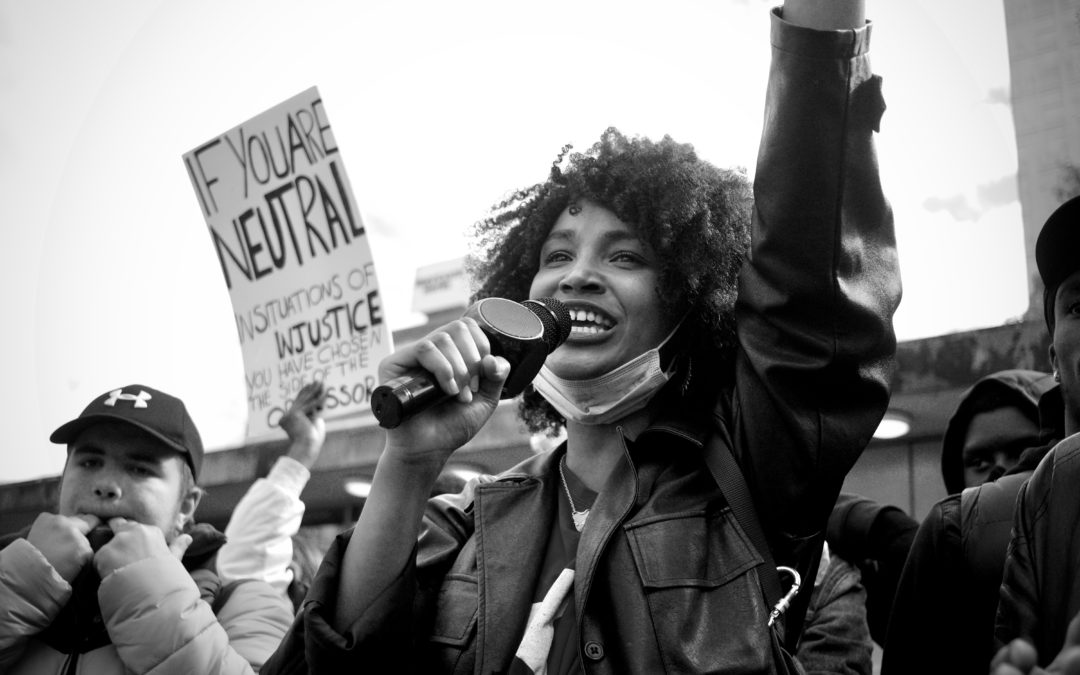Written by: Helen Hope Kimbrough
There comes a time when silence is betrayal. – Dr. Martin Luther King, Jr.
After the murder of George Floyd, the world was ablaze. The final images prior to his death showed him pleading, relenting, and complying, but his voice and actions fell on deaf ears. Floyd did everything in that moment that he was taught to do to secure his safety, but it did not work. The officer failed to see his humanity and avoided his pleas to live and thrive as a human being. Yet, the world heard Floyd loud and clear, and the streets were filled with an estimated half a million protestors exercising their voice on behalf of him and countless others… I was one of them.
Upon witnessing the pain and devastation of this deliberate act of systemic racism, I aspired to do more, listen more, and say more, specifically within the work environment. I reassessed how I wanted to amplify my own voice, and it’s what actually drew me professionally to Next Stage. I no longer wanted to be ingrained in complacency; I wanted to be fueled, emboldened, and empowered to use my voice not in a performative way, but in a meaningful and measurable way. I believe many people share this feeling and are looking to integrate their beliefs with a tangible goal and footprint.
Organizationally, Next Stage incorporates courage as one of its values which states, “We say the stuff that needs to be said,” and we try to make this evident within each client engagement. Likewise, Next Stage encourages organizations to use their voice differently in terms of cultural and equitable advocacy, representation, and embeddedness.
Like many organizations, we’ve wrestled with how to bring this to life in our own work – how to find our own advocacy voice. And while we can’t claim to have all the answers.
Here is a list of six ways we endeavor to bring advocacy into our everyday work.
- Speaking up. Speaking truth to power isn’t always easy – there are times when it would be easier to let a comment or idea pass by. Being honest with ourselves and others, while refusing to be silent about the things that matter is the only way to create change.
- Listening. One of the most powerful ways for organizations and individuals to ally is to invite all different voices and perspectives to the table. When we prioritize listening first, it creates relationships that are the foundation of change. As we’ve increasingly prioritized this in our client engagements, it has been a powerful reminder that the practice of listening makes every solution stronger.
- Using an asset-based framework. This means telling positive and respectful stories about the communities we serve and being intentional about whole-person storytelling. Check out this conversation with Valaida Fullwood and Alicia Bell to learn more.
- Embracing the discomfort. This work isn’t always easy and we don’t always get it right. Embracing uncomfortable conversations and the ‘pain points’ likely means we’re doing something right – that we’re digging in and doing the hard work.
- Forgetting the status quo. Taking a fresh look at community and organizational challenges can mean interrupting the way things ‘have always been done.’ We don’t rock the boat just for the sake of rocking it, but there is often a good reason we keep getting the same results.
- Making authentic connections. Partnering differently often means expanding our network to include new relationships and collaborations. Basing these in genuine relationship means that we are able to partner in new ways, based on trusted relationships.
- Being intentional. We are mindful of our words, deeds and actions as we make decisions, weighing out their impact on others.
These may seem like small steps to amplify, interrupt, and innovate toward systemic change, but the returns are immeasurable and rewarding. How is your organization practically integrating advocacy and shifting towards more inclusivity and equity?
